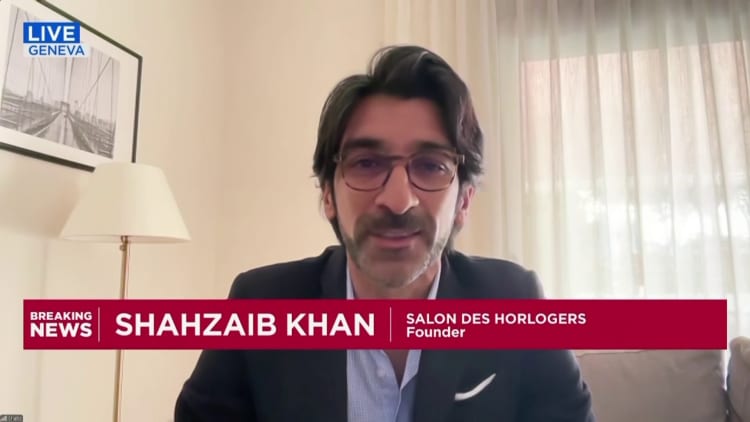Chocolate, skincare and timepieces: What 39% tariffs on Swiss goods mean for U.S. consumers

Premium collection of dark, milk and white chocolates.
Anna Kurzaeva | Moment | Getty Images
U.S. buyers of Swiss products, from luxury watches and skincare to artisan chocolates, could soon face sharp price rises if negotiators are unable to strike a deal to avert 39% tariffs due to come into effect on Thursday.
The announcement last week that Switzerland faces one of the highest U.S. tariff rates in the world stunned many politicians, analysts and businesses, who had thought the country was close to negotiating a deal similar to those of the European Union and U.K., which got baseline rates of 15% and 10% respectively.
The U.S. has a hefty trade deficit with Switzerland, totaling $38.3 billion in 2024. The Swiss government points out that the gap is in part because of the latter’s status as the world’s biggest center of gold refining, with huge quantities of the precious metal passing through the country for processing before it is sent around the world. Both gold and silver were exempted from the White House’s “reciprocal tariff” policy launched in April.
The U.S. is also a major importer of Swiss pharmaceuticals, an industry that has been mired in confusion over the tariff rates it will face, and medical devices. Pharma products are currently exempt from the 39% levies, though sector-specific tariffs may yet come under the U.S.’s separate Section 232 investigation.
But consumers will mostly be familiar with the Alpine country’s high-end products, from Rolex watches to premium skincare and beauty products. Sales could be rocked if the 39% tariffs remain in place for an extended period — something Swiss negotiators are currently scrambling to avoid, as economists warn of a massive hit to growth, jobs and stocks.
Watches
The U.S. was the biggest overseas market for Swiss watches in 2024, with exports totaling 4.37 billion Swiss francs ($5.4 billion), according to the Federation of the Swiss Watch Industry.
To qualify as Swiss-made, at least 60% of a watch’s production cost must be Swiss-based, while its technical development must be conducted in the country.
“Swiss watches have long been a cornerstone of the U.S. market, and a 39% tariff would be a real shake-up,” Paul Altieri, founder and CEO of online resale platform Bob’s Watches, told CNBC.
“Suddenly, every import would carry a hefty extra cost, and dealers would face tough choices — absorb the tariff, eat into margins, or pass it on to customers. You’d likely see longer lead times as brands and retailers realign logistics, and higher sticker prices across the board.” The retail price of a Rolex Submariner could jump from $10,000 to nearly $14,000, he noted.
For Swiss watch businesses, a 39% tariff would be “devastating,” Jean-Philippe Bertschy, head of Swiss equity research at Vontobel, told CNBC’s “Squawk Box Europe” on Tuesday.

“They increased the prices already in spring by an average of 5 to 10%, I think another hit will be quite difficult for the U.S. consumer for sure, especially for the entry into the mid-segment level.” In a research note, Vontobel flagged Swatch as vulnerable to a tariff hit, with shares falling 2.3% on Monday.
“For the luxury watches, for the brands like Rolex, Patek Philippe and Audemars Piguet, you have some long waiting lists. So I think it’s going to be more comfortable for these companies to increase the prices,” Bertschy continued.
“You have very limited measures to take. You can, of course, increase efficiencies and to try to do some other measures to counter U.S. tariffs, but overall, very challenging for the industry.”
Coffee
Consumer goods giant Nestlé is one of Switzerland’s biggest firms. The company says that it faces a minimal direct impact from tariffs because it produces more than 90% of what it sells in the U.S. locally.
That’s generally the case for consumer staples such as instant coffee or bottled water which are high-volume, low-ticket items, James Edwardes Jones, managing director of consumer research at RBC Capital Markets, told CNBC’s “Squawk Box Europe.”
Its popular Nespresso coffee brand, known for at-home coffee machines and capsule pods, could, however, be among those goods exposed to higher rates and therefore price hikes.
“In Nestle’s case specifically, Nespresso is all manufactured in Switzerland and then exported around the world, so it seems likely that will be caught in a small way,” Edwardes Jones added.
Nestle did not immediately respond to CNBC’s request for comment on the impact of Swiss levies. The company does not specify the level of its U.S. sales for Nespresso, but its half-year results showed North America grew at a “strong double-digit rate.”
Skincare
Switzerland’s world-renowned beauty and skincare products could also be subject to price hikes as brands not included in a pharmaceutical tariff exemption look to offset higher import costs.
That could be most notable for companies that pride themselves on Swiss production, such as caviar-based anti-aging skincare brand La Prairie, spa supplier Valmont and nail care business Mavala, none of which responded to CNBC’s request for comment.
“While Swiss firms can generally weather a 10-15% tariff without major margin erosion or demand loss, 39% sets the bar much higher,” Lombard Odier said in a Monday note.
Lausanne-headquartered Galderma, whose products include injectable aesthetics and Cetaphil facewash, meanwhile, said that it does not produce in Switzerland and is currently largely excluded from global tariffs under pharma exemptions.
However, its large production capacity in the European Union, U.K. and Canada could be subject to higher levies, potentially hitting consumer costs.
Luxury
Higher import duties are also seen pushing up the price of luxury goods, including Richemont-owned high-end jewelry brands Cartier and Van Cleef & Arpels.
BofA Securities said in a note Tuesday that 7% of Richemont’s input costs would be exposed to higher Swiss tariffs, likely adding to higher consumer prices. “Price increases would be the most obvious way to mitigate the headwind,” the analysts wrote.
Cartier, a unit of Cie. Richemont SA, luxury watches sit on display in a store front.
Bloomberg | Getty Images
Richemont did not respond to CNBC’s request for comment on the 39% rate, however it flagged in its first-quarter earnings that tariffs could lead to “increased prices,” which could impact consumer demand.
Lombard Odier noted that a “small fraction” of luxury exports could see demand for their products increase with price, but broadly price hikes were set to hurt consumer demand.
Chocolate
Roger Wehrli, director of Swiss chocolatiers’ manufacturing association Chocosuisse, said a 39% tariff rate would be passed on via prices and cause a steep loss of U.S. business for many of the group’s members. The recent appreciation of the Swiss franc against the U.S. dollar, which causes imports to become more expensive, means the effective price increase would be closer to 55%, he noted.
The main impact will be on small- and medium-sized businesses that are unable to utilize U.S. production sites like big multinationals can, Wehrli said. Industry juggernauts Lindt & Sprüngli and Barry Callebaut already have factories stateside, while smaller Chocosuisse members such as Camille Bloch and Läderach produce exclusively in Switzerland.
“There’s another specific problem with producing in the United States,” Wehrli continued.
“If you want to label your chocolate as Swiss then it has to be produced in Switzerland. That’s a quality sign in the international market, so you will more or less lose your customers if it’s not Swiss origin anymore,” Wehrli told CNBC.
These rules of origin forced Toblerone, owned by U.S. group Mondelez International, to change its packaging in 2023 to refer to itself as being “established in Switzerland” rather than “Swiss chocolate” after it moved some of its production from the Swiss capital Bern to Slovakia. CNBC has contacted Mondelez for comment on the impact of tariffs on Toblerone in the U.S.




